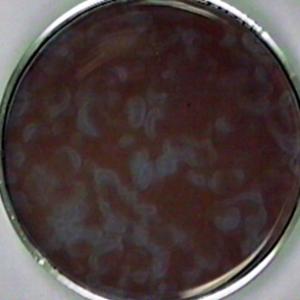College of Liberal Arts & Sciences
3A95.59 - Belousov - Zhabotinsky Reactions
See also 3A95.59 in Oscillations/Acoustics.
The simple reaction directions are in the box. Do not make more that 100 mls of each of the A, B, and C stock solutions for final demo mixing as there is some gas evolution during the reaction/digestion process. 40 mls of each stock solution mixed for the final demo seems to work very well. Add 1 ml or the starch solution.
The more involved chemical reaction is as follows: The mixing of chemicals needs to take place before hand. This also take quite a bit of time, so make sure to allow at least 24 hours to get this demo ready. Refer to the file for chemical proportions and mixing instructions.
For every 100 ml of solution use:
| 0.33g | Malonic Acid |
| 0.95g | NaBrO3 |
| 0.55g | Ceric Ammonium Nitrate |
| 4.5 ml | H2SO4 |
**For the KBr make a stock solution using .2 grams KBr per Liter. Use 1 ml of this solution for each 100 ml of reaction solution.
- Sergey V. Buldyrev, Melissa J. Erickson, Peter Garik, Linda S. Shore, H. Eugene Stanley, Edwin F. Taylor, Paul A. Trunfio, and Paul Hickman, "Science Research in the Classroom", TPT, Vol. 32, #7, Oct. 1994, p. 411.
- Eugenie V. Mielczarek, Jack S. Turner, Darryl Leiter, Linda Davis, "Chemical Clocks: Experimental and Theoretical Models of Nonlinear Behavior", AJP, Vol. 51, #1, Jan. 1983, p. 32.
- Richard J. Fitzgerald, "Complex Patterns in Frustrated Synchronization", Physics Today, Vol. 69, #2, Feb. 2016, p. 18.
- Johanna Miller, "A Nonbiological System Offers Insight Into Biological Synchronization", Physics Today, Vol. 62, #4, Apr. 2009, p. 14.
- Charles Day, "Feedback Tames Chaotic Surface Chemistry", Physics Today, Vol. 54, #7, July, 2001, p. 18.
- Irving R. Epstein, "Spiral Waves in Chemistry and Biology", Science, Vol. 252, #5002, Apr. 1991, p. 67.
- Jearl Walker, "Chemical Systems That Oscillate Between One Color and Another", The Amateur Scientist, July 1978, p. 152 - 161.
- Gene Gennaro and Bruce Munson, "The Iodine Clock Reaction and Hypothermia", The Science Teacher, Vol. 55, #9, Dec. 1988, p. 16 - 19.
- Neil. A. Downie, "2. Glacial Oscillations", Ink Sandwiches, Electric Worms and 37 Other experiments for Saturday Science, p. 13 - 19.
- A. Babloyantz, "The Belousov - Zhabotinski Reaction", Molecules, Dynamics, and Life, 1986, p. 155 - 172.
- Earle S. Scott, Rodney Schreiner, Lee R. Sharpe, Bassam Z. Shakhashiri, and Glen E. Dirreen, "7.2 Cerium-Catalyzed Bromate-Malonic Acid Reaction", Chemical Demonstrations, Vol. 2, p. 257 - 261.
- Earle S. Scott, Rodney Schreiner, Lee R. Sharpe, Bassam Z. Shakhashiri, and Glen E. Dirreen, "7. Oscillating Chemical Reactions", Chemical Demonstrations, Vol. 2, p. 232 - 247.
Disclaimer: These demonstrations are provided only for illustrative use by persons affiliated with The University of Iowa and only under the direction of a trained instructor or physicist. The University of Iowa is not responsible for demonstrations performed by those using their own equipment or who choose to use this reference material for their own purpose. The demonstrations included here are within the public domain and can be found in materials contained in libraries, bookstores, and through electronic sources. Performing all or any portion of any of these demonstrations, with or without revisions not depicted here entails inherent risks. These risks include, without limitation, bodily injury (and possibly death), including risks to health that may be temporary or permanent and that may exacerbate a pre-existing medical condition; and property loss or damage. Anyone performing any part of these demonstrations, even with revisions, knowingly and voluntarily assumes all risks associated with them.
